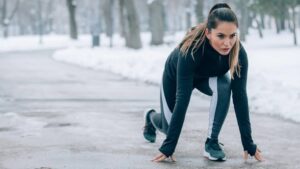

Cold weather does not have to put a halt to your outdoor exercise routine. You can still exercise in the cold weather if you take precautions.
Put on appropriate clothing
The right Clothing is crucial. Although a double-thick cotton sweatshirt appears to be a good option, it does not insulate as well as synthetic fabrics such as lightweight polyester, polypropylene, or moisture-wicking materials.
Avoid overdressing. Even in subzero temperatures, it is possible to overheat. You’ll sweat a lot if you dress too effusively. Then, when winter winds strikes, sweat will quickly evaporate, chilling you. You want to keep perspiration to a minimum and away from your skin and the outside air.
Please pay attention to your Head
You can lose a lot of heat through your exposed head, so use a hat, cap, or hood.
Your feet are the first to become cold. Wear the appropriate boots or shoes. Keep them dry and warm by wearing warm socks.
Your hands are more susceptible to cold due to the obvious sizable surface area to volume ratio. Before the hands become cold, gloves or fingerless gloves should be worn. Mittens are preferable to gloves because the fingers can warm each other and the mitten reduces the exposed surface area.
Layering is essential.
Wear something synthetic against your skin. This allows sweat to pass through the textile and away from your body. For primary insulation, the second layer should be tweed, synthetic fibers, or fake fur. The third layer should be chosen because it can keep out cold air, wind, and rain. This layer should be light and synthetic in nature.
Layering also aids in temperature regulation. If you get too hot, you can remove a layer.
Other cold-weather suggestions
- Getting warmed up prior to actually excercise always is important, but it is especially important when it is cold outside.
- If you drive to your workout location, make sure you have emergency supplies on hand, such as covers and a portable charger.
- If the temperature is particularly cold, you should probably avoid exercising outside. If you must go outside in extreme cold, cover all exposed skin to avoid frostbite. Understand hypothermia symptoms such as shivering, tiredness, paleness, and confusion.
- Cold air does not harm the lungs. By the time air reaches the lungs, it has warmed to body temperature. Cold air, on the other hand, can set off an asthma attack in some people.
Check Out Related Health Posts Below













